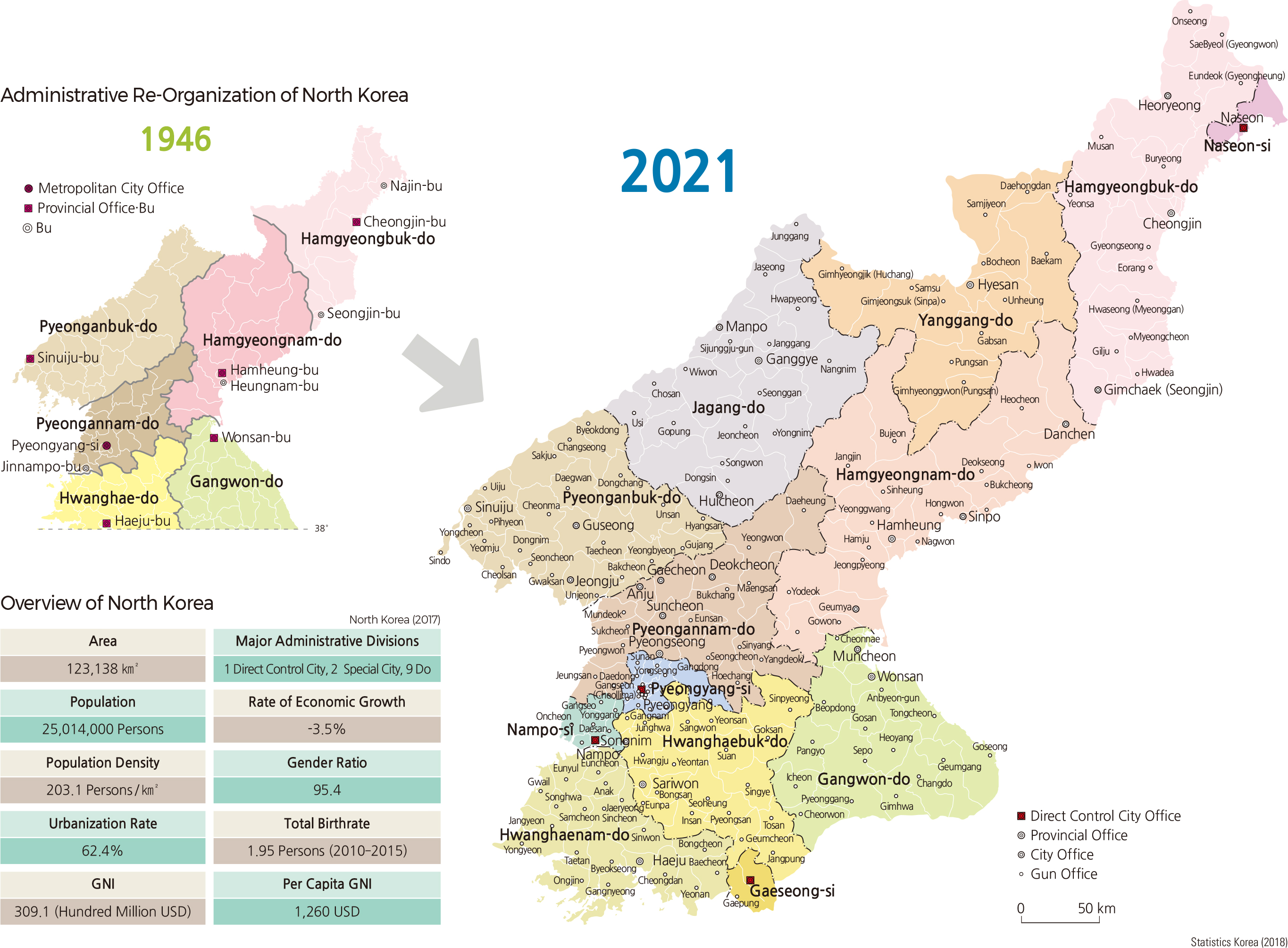Comprehensive Edition 2022
North Korea lies north of the demarcation line set by the Korean Armistice Agreement in July 1953. Its total area is 123,138 km², accounting for approximately 55% of the entire Korean Peninsula, which is 223,516 km². As of 2017, the population of North Korea was about 25,014,000, and its population density was 203.1 persons/km². This is close to 40% of that of South Korea, whose population density is 512.6 persons / km². North Korea faces the East Sea to the east and the Yellow Sea to the west; it shares a border with the northeastern part of China along the Amnokgang River (Yalu River) and Dumangang River (Tumen River) and with Russia’s Siberia along the Dumangang River. The boundary with China is 1,353.2 km long and features bridges such as the Amnokgang Bridge, which enables road and railway traffic to flow between Sinuiju in North Korea and Dandong in China. North Korea shares a border with Russia that is 16.2 km long and is connected by a railroad bridge between North Korea’s Dumangang Station in Naseon (Rason) and the Khasan Station just across the border in Russia. To the south, North Korea’s border with South Korea consists of the Military Demarcation Line.
North Korea is in a temperate climate region and has a continental climate. Its winters are frigid as a result of northwestern winds that blow from Siberia, and the summers are hot and humid due to the southeastern monsoon winds that bring moist air from the Pacific Ocean. The average annual rainfall is between 600–1,500 mm, and 53–63% of all precipitation occurs from June to September. The overall rainfall is less than that of South Korea and varies widely depending on the region.
In the past, North Korea had an abundance of natural resources with ecological value. However, its forests have been consistently damaged due to programs such as “Nationwide Fortification,” one of the four military campaigns that began in the 1960s; “Terraced Field Farming,” one of the five nature reformation campaigns that began in the 1970s; and the project of “New Field Finding,” which began in the 1980s. Particularly in the 1990s, forests were devastated as financial difficulties forced people to find food and fuel in the mountains.
Most North Koreans live in the southern and western parts of the country in the plains and lowlands. Pyeongyang and its neighboring Pyeongannam-do have the highest population density. The population density is generally low in the mountainous northern and eastern parts, with the exception of scattered cities and the eastern coastal area.
North Korea’s economy is a centrally planned and unified system in which the State Planning Commission of the central government announces economic development plans and strictly controls smaller economic units, such as regional governments, factories, and companies. Along with a centrally planned system, another important feature of North Korea’s economy relates to the country’s plans to assign top priority to develop heavy industry with parallel developments in agriculture and light industry. Despite these plans, due to a lack of capital and resources, heavy industry was favored over light industry and agriculture. With the collapse of communist governments around the world during the 1990s, the problem of favoring heavy industry and ignoring agriculture and light industry became serious, and it led to financial difficulties and food shortages in the mid-1990s. The North’s economy began to recover after 1999, but it has experienced an average annual negative growth rate since 2006.
Although North Korea’s energy supply still relies heavily on coal, energy supply from coal decreased from 70.2% in 2005 to 43.2% in 2016. On the other hand, hydroelectric power almost doubled from 17.6% in 2006 to 32.3% in 2016. Oil imports fluctuated from 4.4% to 11.8% due to external factors such as international sanctions and the Sino-DPRK relationship. In the case of North Korea’s food supply and demand, its food shortage has decreased in comparison to the mid and late 1990s, when it suffered from a severe food crisis. Since 2013, North Korea has maintained agricultural production at an average of 4.8 million tons every year, which has lowered the annual average food deficit to 0.53 million tons. However, as the ratio of recent year-to-year food production versus demand rose from 80% to 90%, it is too early to tell if the food supply has stabilized.
|






